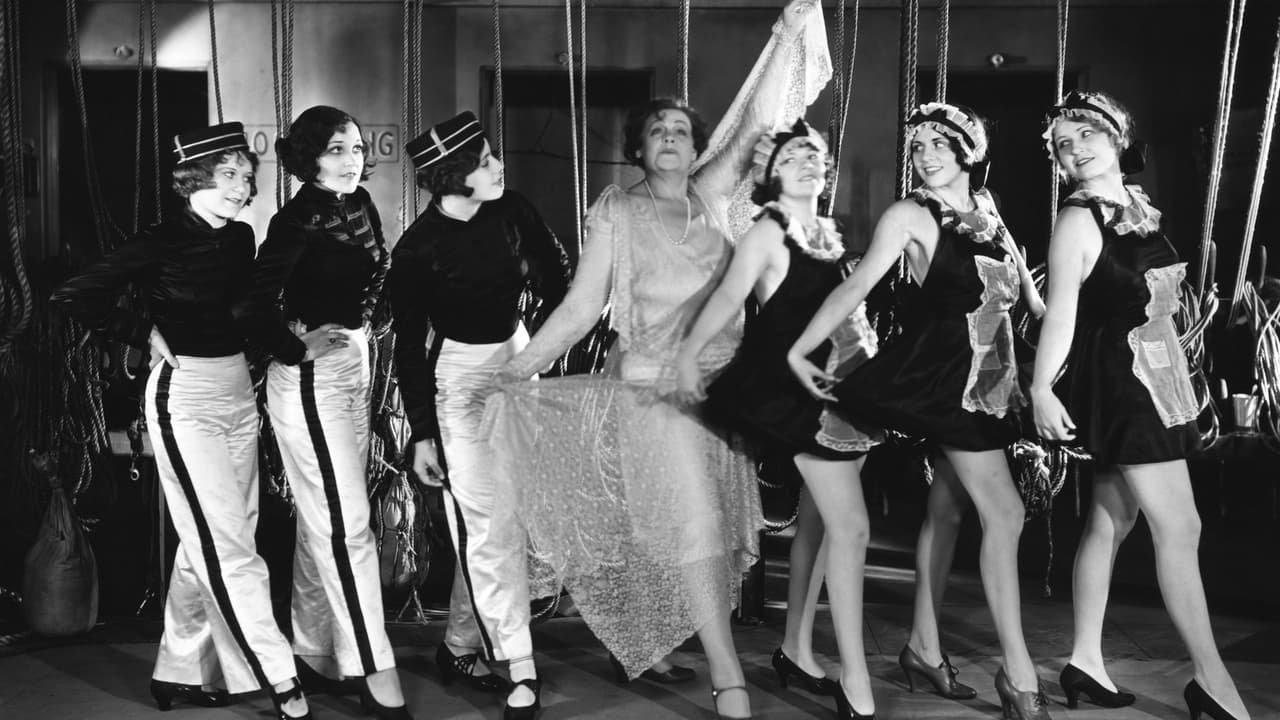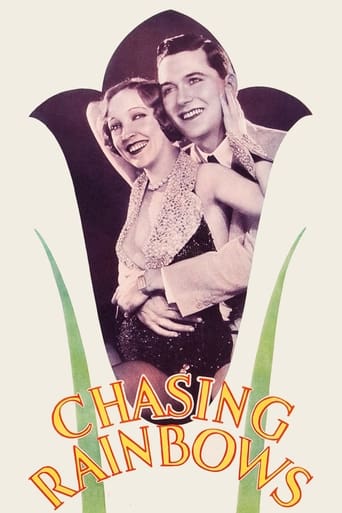



i know i wasted 90 mins of my life.
This movie feels like it was made purely to piss off people who want good shows
View MoreExcellent and certainly provocative... If nothing else, the film is a real conversation starter.
View MoreLet me be very fair here, this is not the best movie in my opinion. But, this movie is fun, it has purpose and is very enjoyable to watch.
View MoreI won't repeat other reviews; I agree with almost all comments. What I'd like to address is the unprofessional editing. In one scene actors apparently are listening to Jack Benny lecturing but without sound. This is clearly a medium reaction shot, meant to have Jack's voice over. Poly Moran stands in a doorway without moving for about three seconds before action begins. An actor enters a door from the outside - you can't see the door - and then the camera pauses. Then on the inside we see the door continues to open. At the trimmed fade out you see the door start to open again. This is an A picture made by an A studio. Such gaffes are unforgivable.
View MoreI don't usually see things the way that everybody else does, but in this case, I do. The other reviews here are pretty spot on. I enjoyed the film. It had strengths, but it also had flaws. In fact, three of each.The three strengths were Jack Benny, Marie Dressler, and Bessie Love. I've always been a Jack Benny fan, and he does not disappoint here. His sharp, fast one-liners are a funny and very welcome part of the movie. This was my first introduction to Marie Dressler, and I'm an instant fan; she was just marvelous. Probably the best part of the movie. And finally, I loved Bessie Love's work here. The Carlie character she brings to life is sweet and sincere and adorable, and you quickly find yourself pulling for her. I would've gone for Carlie in an instant.As for the flaws, the biggest is Charles King's Terry Fay. I can't even assess Kings performance, because the character itself, as written, is just so horrible. He's a romantic lummox and comes across as both moron and jerk. By the time we learn that he's married Daphne, I completely hated him and didn't *want* Carlie to end up with him; she was just too good for him and deserved much better. That's a pretty big flaw in a romance.The other two flaws were more minor, and one of them wasn't the film's fault. First, I found the romantic resolution to be lame. After all the romantic vacillations and tribulations, we were entitled to more of a payoff at the climax. The long-awaited final get- together is just so rushed and skipped-over, its like the film makers themselves really didn't care. But part of the problem may be related to the second flaw: the fact that the film is missing a number of scenes. As others have already pointed out, there are a number of scenes which were filmed in early 2-color Technicolor (whatever exactly that is), which are missing. From the descriptions that the cobbled together available version provides, it seems like they were just set-piece stage numbers. But that includes the *entire* ending of the film. Maybe somewhere within all that missing stuff, more was developed to support the final get-together of the two leads. Even if it were all just wordless, looks and expressions and whatever. Maybe that's part of why the resolution feels so thin and rushed.Regardless, I would pay a lot to see the film restored to its original form. If for no other reason than to get to see one more number with Marie Dressler!
View More"Chasing Rainbows" (Metro-Goldwyn-Mayer, 1929-30), directed by Charles F. Reisner, was the studio's attempt in duplicating the success of its very first all sound musical titled "The Broadway Melody" (1929), that won the Academy Award as Best Picture. To review "Chasing Rainbows," one cannot help but compare this to "The Broadway Melody," a backstage story revolving around a sister act (Bessie Love and Anita Page) that nearly breaks up on account of their love for the same leading man (Charles King). Aside from the re-teaming of Love and King, this new edition, set in small town theaters during a road show tour instead of the Broadway theater district, substitutes troublesome leading ladies over kid sisters to complicate matters. Love, whose climatic crying scene from "The Broadway Melody" that earned her an Academy Award nomination as Best Actress, attempts doing same thing here with her moment of hysterics, this time with laughter. As much as the situations are basically the same, the results aren't. Although the film's title might indicate an old favorite of "I'm Always Chasing Rainbows" as one of its highlight production numbers, it actually began production as "Road Show" a title more appealing to the plot at hand.Following the opening title credits over the visual of a passing train, and minus any underscoring, the plot gets underway with the closing of the road show performance of "Good-bye Broadway" where the cast gathers together in the big finale. Eddie Brock (Jack Benny), the stage manager, gets the company ready for their next engagement in another town. Terry Fay (Charles King), the leading man, is blind by the true love of Carlie Seymour (Bessie Love), his partner of five years. Upset over Peggy (Gwen Lee) quitting the show and leaving with another man, Terry threatens suicide until Brock acquires Daphne Wayne (Nita Martan) as the show's new leading lady. Terry falls for Daphne, who, in reality, is using him for her own professional gain. After Carlie discovers Daphne carrying on an affair with Don Cordova (Eddie Phillips), her former leading man, she tries to warn Terry, who refuses to listen. Even after he realizes Carlie accusations are correct, Terry, still blinded by Daphne's presence, marries her, complicating matters all around.For the motion picture soundtrack, songs (*indicating two-strip Technicolor sequences) include: "Happy Days Are Here Again" (sung by chorus); "Pure But Honest" (sung by Marie Dressler); "Lucky Me and Lovable You" (sung by Charles King); "Do I Know What I'm Doing?" (sung by Nita Martan, reprized by Marie Dressler and Polly Moran); *"Everybody Tap" (performed by Bessie Love); *"Love Ain't Nothing But the Blues" (sung by Charles King); "Lucky Me and Lovable You" (reprised by Charles King); *"My Dynamic Personality" (sung by Marie Dressler) and *"Happy Days Are Here Again" (sung by chorus). Considering its bright score, only "Happy Days Are Here Again," twice performed briefly, remains relatively known to this day. "Lucky Me and Lovable You," the film's best song, used for underscoring during the tender moments between King and Love, did not recapture the similar mood and qualities of "You Were Meant For Me" that was introduced in "The Broadway Melody." While "Chasing Rainbows" improves technically over its primitive production style of "The Broadway Melody," which simply lacked the brighter moments supplied by Marie Dressler and Polly Moran in their usual feuding pal roles. Dressler, shortly before achieving super stardom following her Academy Award winning performance in "Min and Bill" (1930), not only gets a chance to sing, but shares a drunken scene with Moran, cast here as the wardrobe woman. Fans of Jack Benny's radio and TV show can get an early glimpse of the popular comedian before reaching 39 playing a straight man providing some funny one-liners here and there.Of all the musicals produced during the early sound period, "Chasing Rainbows" is truly a forgotten one. Due to the missing two-strip Technicolor musical sequences, shortening its original length from 100 minutes to 86, "Chasing Rainbows" has never been televised, at least until the era of Turner Classic Movies following its 1984 premiere where this musical became part as its very own film preservation series where still photos for the missing sequences were inserted with sub-titles indicating its actions filling in the void. With that said, "Chasing Rainbows," in spite of Charlie King's occasional annoying character portrayal, proves not only one of the more worthier rediscoveries of the early sound era, but a good companion piece to the much better known "Broadway Melody." (** curtain calls)
View MoreI really love this film - that is, what is left of it. What remains is roughly the 85 minutes which comprise the dramatic portion. What is missing are the Technicolor numbers, or approximately 20 minutes. TCM has inserted publicity stills with title cards telling the audience of any plot developments that happen during the missing scenes, and all in all it is quite watchable in its current state.This movie reunites Bessie Love and Charles King from "Broadway Melody" fame of the year before, and throws in Jack Benny, Polly Moran, and Marie Dressler of "The Hollywood Revue", also from 1929. Many people describe this film as a redo of the Broadway Melody formula, but it really is quite different from that. The film follows the troupe of the show "Goodbye Broadway" as it moves from town to town during one theatrical season. Here Charles King plays vaudevillian Terry Fay who is oblivious to the fact that his partner, Carlie, (Bessie Love) is in love with him. Terry makes a play for every leading lady on the vaudeville circuit. Of course they use him, of course they break his heart, and of course he goes right out and does it again. However, he finally meets his match in Daphne Wayne (Nita Martin) who sees in Terry a way to make it to Broadway and off the road show circuit. Plotwise, it isn't much, but plot really isn't the point of these early talkie back-stagers. Bessie Love comes across wonderfully as the taken-for-granted partner. You can really feel the emotional roller-coaster she is on as she thinks she may have finally gotten to Terry only to find out he's thrown her over once again. Jack Benny is great as the wise-cracking stage manager. MGM has thankfully dropped the lechery angle that he had in Hollywood Revue and instead has him adding in his biting sarcastic wit here and there, showing us a taste of what will make him a success in radio. Polly Moran and Marie Dressler are hilarious as two aging ladies of the vaudeville scene, long-time friends who are constantly at each other's throats.The whole group plays together with such chemistry, yet Jack Benny himself always kidded about how this film landed with a thud when it opened in 1930, calling it "Chasing Customers". If you like any of the stars I've mentioned and the early talkie musicals, this one is worth watching and even has a few songs in it. If it had been released a year earlier it would probably have been a major hit and be intact today. Had it been made a year later - well, it wouldn't have been made at all a year later because by 1931 nobody was making musical films anymore. This is really worth seeking out, just don't be surprised by the condition the sound and video are in. The film really looks shaggy compared to how well the other early MGMs have been preserved.
View More